#charles using carlos' love language (violence)...
Explore tagged Tumblr posts
Text
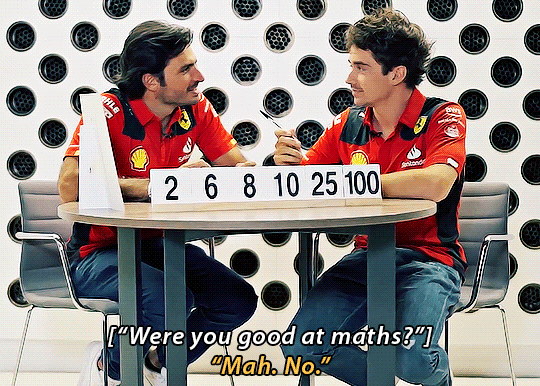




C² Challenge '23 // Countdown
#carlos' fond eyes...#charles using carlos' love language (violence)...#god they are soooooo#like do they ever take a break from being married?#i'm so sorry for the excessive holes in the background#it's both visually overwhelming and (for some people) triggering smh#charles leclerc#carlos sainz#charlos#c2 challenge#2023#gifs#mine#formula one#f1#ferrari
706 notes
·
View notes
Text
These bitches will be the death of me.
Every interaction this year is just a stab in the heart and a cruel reminder that this time next year they won't be teammates anymore. Just co-workers. Ex-teammates. No more fun games and interviews. No more challenges where Charles tries to cheat. No more Carlos using violence as his love language on charles. No more charlos. Somebody sedate me😭😭😭
115 notes
·
View notes
Text

―the devil and the runaway au!
about:
Contrary to popular belief, the Devil doesn’t have red skin, graphite horns, and a wickedly sharp tail. He’s not a fallen Angel, he doesn’t carry a pitchfork, and he definitely doesn’t look like a monster.
The Devil wears three piece suits, expensive watches, and can hit a running target from about a hundred metres away. He’s the heir to an Empire, he carries fourteen knives and three guns on him at all times, and he’s got killer dimples.
He’s heartless, the people of Monte-Carlo whisper. His prince-like eyes and silver-tongued compliments will pull you in... before he leaves you with a bullet between the eyes.
The people of Monte-Carlo know better than to catch the eye of the Devil.
You knew better.
And yet there you are, hiding from the chaos around you, calling for help with the Devil's own phone.
summary:
Y/N lived for her father. She spent her childhood hoping he would love her, even if he never asked for her, even if he saw her as nothing but a weapon.
Y/N lived for her lover. Teenage sweethearts, loved by her father, this was the one person who Y/N hoped would change her life. He did... just not for the better.
Y/N lives for her son, Nico. Two years old, and a mixture of the past she ran away from, she never realized she could love someone as much as this tiny human.
Charles wants Y/N to live for herself.
gangs:
The Ferras
The Ayrbees
The Mercs
The Martins
The Lars
notes:
this is a mafia!charles leclerc x reader!au. that being said, there will be typical gang violence, death, swearing, etc
the name of the reader is y/n meadows, a 24 year old who's currently residing in monaco and is the owner of a small cat cafe (les chats de l'amour). she resides in a two-bedroom apartment built above the cafe.
i will try to include most of the 22 grid and maybe even the new members of the 23' grid, but idk if they'll all be there
the gangs are based off of ferrari (ferras), mercedes (mercs), redbull (ayrbees), the martins (aston martin), and mclaren (lars). there will be interchanging between the gangs/teams, meaning ppl who drive for mercedes might be with the ferras and vice versa. it's just a loose basing
the lars are a small gang
the prema boys are based off of prema racers / fda, and is the step below being a member of the ferras
google translate was used for anything i don't know how to say in other languages
this will most likely have a prologue + 10 parts of about 3k words each!
be sure to like, rb and comment as it makes me really happy!
masterlist:
PROLOGUE
TAGS
#the devil and the runaway! au#naqia's au's!#charles leclerc fanfic#charles leclerc mafia#mafia!charles leclerc#charles leclerc mafia au#mafia!f1#mafia!au#f1 x reader#f1 imagine#f1 masterlist#f1 blurb#charles leclerc#charles leclerc fic
398 notes
·
View notes
Text
Unhappiness And Deviancy
read it on the AO3 at https://ift.tt/3AnaVcz
by SheIsHoldingACat
It's been a few years now, since Desert Bluffs was fully occupied. Since Kevin lost his mind, and Daniel lost his humanity. Now, Daniel and Lauren, awakened to the atrocities that StrexCorp commits, are lost, with nobody but each other to confide in.
That is, until they become involved in the Bluffisan Traditionalist movement, a group invested in returning the town to it's former state, lead by the charismatic W. N. Marats.
But then, a notebook, belonging to one of StrexCorp's most powerful members goes missing, and Daniel finds himself caught up in a mind bending conspiracy. He knows he has to save himself, Lauren, and Desert Bluffs, but he doesn't know if he has to sacrifice what's left of his fragile humanity to do it.
Words: 5404, Chapters: 2/?, Language: English
Fandoms: Welcome to Night Vale
Rating: Teen And Up Audiences
Warnings: Graphic Depictions Of Violence, Major Character Death, Rape/Non-Con
Categories: Multi
Characters: Lauren Mallard, Desert Bluffs Carlos, Kevin (Welcome to Night Vale), Daniel (Welcome to Night Vale), Original Strexcorp Character(s), Background & Cameo Characters, Diego (Welcome to Night Vale)
Relationships: Daniel/Lauren Mallard, Kevin/Lauren Mallard, Diego/Kevin (Welcome to Night Vale), Daniel/Pretty Much Everyone, Daniel/Original Plot Relevent Characters
Additional Tags: Drama & Romance, Established Relationship, Mystery, Psychological Thriller?, Horror Elements, Kevin Typical Violence, Attempted Sexual Assault, It Was FOILED!, Daniel And Lauren Love Eachother Very Much, Yes I'm Team Diego In 2021, But I Think Charles Is Okay Too, Minor Character Death, Major Enough Character Deaths, implied/reference prostitution, Beta Read By My Grandmother So It Has To Be Good, Daniel Has A Fan Like A Computer Just Go With It, Drugs, They're Plot Relevent, I'm Putting My Pharmacology Studies To Good Use, Desert Bluffs, Desert Bluffs Scenery, Kevin Is Described, Everyone Is In An Open Relationship So Suspend Your Disbelief, Detroit: Become Human x We Happy Few, Basically, Lauren Is A Rebel, Daniel Is A Rebel, Suspense, Kevin is Inhuman, Daniel Is Slightly Human, Daniel-centric, Alternate Universe - Canon Divergence, But only a little, Run-On Sentences, A lot of them - Freeform, Angst and Hurt/Comfort, Plot Important OCs, Vanessa Isn't Mentioned, Purposeful Over Use Of The Word Productive, Strexcorp is Evil, Desert Bluffs Has Southern Gothic Vibes And I'll Die On This Hill, Pre-Canon, Prequel To WTNV, Daniel Passes Out A Lot, Daniel And Connor Should Interact, Don't Stare Into The Sun, Lauren Does NOT Mess Around, Lauren Is A #girlboss, Loosely Based On 1984 (George Orwell), parties and galas, Intrigue, Thousanth Floor Elements, Daniel Is A Detecive, Angst, Heavy Angst, Possibly Too Much Symbolism, Religious Imagery & Symbolism, Female Yawgmoth, of a kind - Freeform, This Is Creepier Than It Looked Originally, Kevin's Origin Is Mentioned, In Slight(?) Detail, Kevin's Studio Is Thankfully Not Described, Well - Freeform, It's Kinda Described, Kevin's Self Worth Issues, Secret Rebel Meetings
read it on the AO3 at https://ift.tt/3AnaVcz
1 note
·
View note
Text
The Best (and Worst) Free Comics of FCBD 2018

Of the fifty-two comics released for Free Comic Book Day 2018, there were an unsurprisingly high number of excellent comics in this year’s class. Here are my picks for the best of the best (with a few dishonorable mentions too) from the many choices available this year.
THE BEST
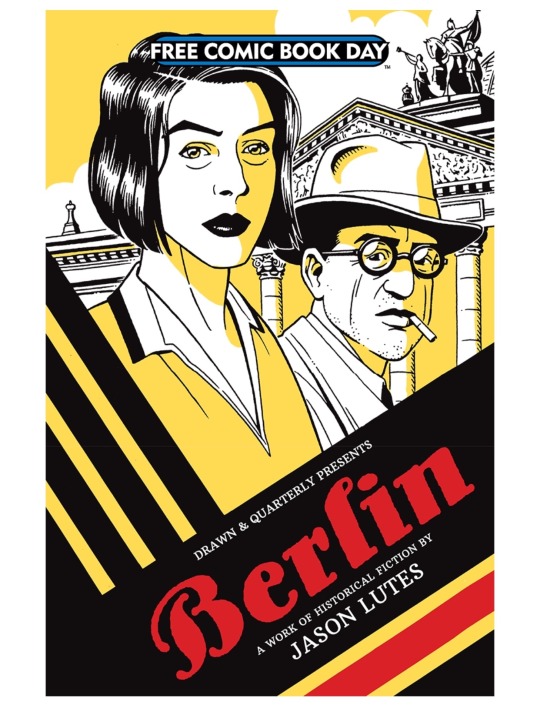
10. BERLIN by Jason Lutes (w, a, c). (Drawn & Quarterly).
Set in 1928 Germany, a journalist and an art student meet on a train to Berlin; when they arrive, the young student is surprised by what she sees, and the journalist must navigate a changing climate for the press. Narrated in part by the main characters’ writings (his reporting and her diary), this street-level view of Berlin prior to the rise of fascism is masterful and cinematic. Even in this preview, the sense of menace and dread to the events that are to come in the story permeates every page. Absolutely genius. Part of a series written over the past twenty years, this FCBD release promotes the hardcover omnibus of the series due for release in fall 2018.

9. STRANGERS IN PARADISE by Terry Moore (w, a). (Abstract Studios).
The issue opens with an exciting pickpocket scene in which Scott, a generic business type, has his phone and SIM card stolen. He later contacts his wife, Laura, to tell her that he’ll be late coming home and why, prompting Laura to stoically retrieve her run bag and leave home for good. The phone thief heads to Laura’s house to discover she’s already gone and runs into Scott; the thief reveals that “Laura” is actually Stephanie Kelly, a Parker girl caught up in treason and espionage. This is a dynamic, fully realized introduction to what seems like a fun and exciting story loaded with intelligent, powerful women kicking all kinds of ass.
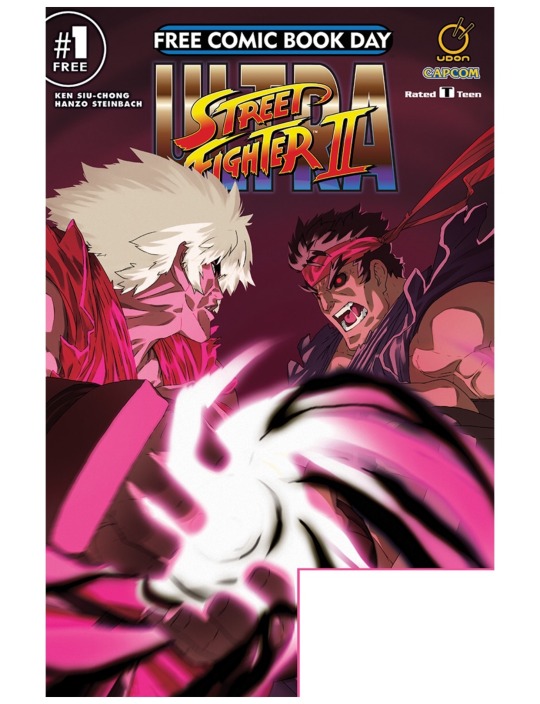
8. ULTRA STREET FIGHTER II #1 by Ken Siu-Chong (w), Hanzo Steinbach (a), Marshall Dillon (l). (Udon).
Trying to shake off his dark side, Ken meets with Ryu to fight through his worst urges and achieve some balance in his life. The pair travel to Japan for some high-level meditation (and fighting, of course), but that only gets Ken so far. Later in San Francisco, Ken is surprised by an attack from Rufus, and during the battle, he learns to control his evil within. Although this comic attempts to apply drama to a fighting video game, the result is fun, colorful, ridiculous, and delightfully entertaining. What more could you want out of a Street Fighter comic?
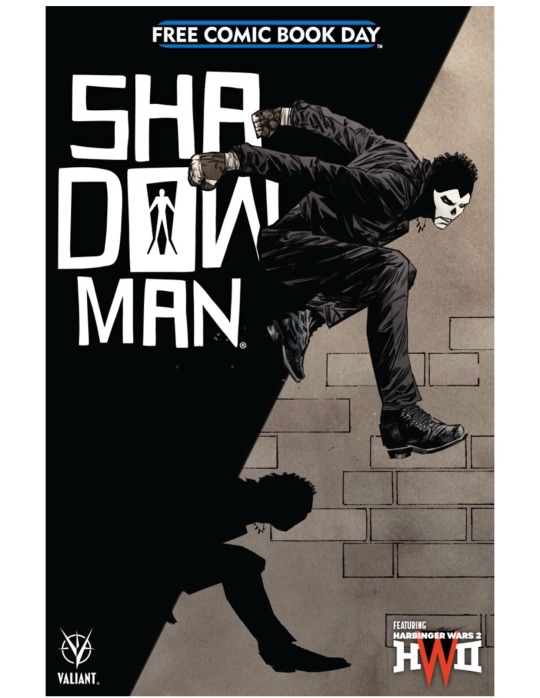
7. SHADOWMAN by Andy Diggle (w), Stephen Segovia (w), Karl Bollers (e). (Valiant).
Alyssa and her guide Isiah explore the swamps of Louisiana at night, searching for the cause of cursed water that’s making locals sick. She encounters a monster, the Grinder of Bones, and tries to use magic to protect herself to no avail. She runs, and summons Papa Legba for guidance: in return, her friend Jack, now the Shadowman, appears from a portal to help her in her fight. With gorgeous artwork, beautiful coloring, and a plot like nothing else on the stands right now, this issue draws readers into this world so effortlessly that it’s hard to imagine someone reading this issue without being fully engrossed and wanting to pick up the whole series. Terrifically well-done.
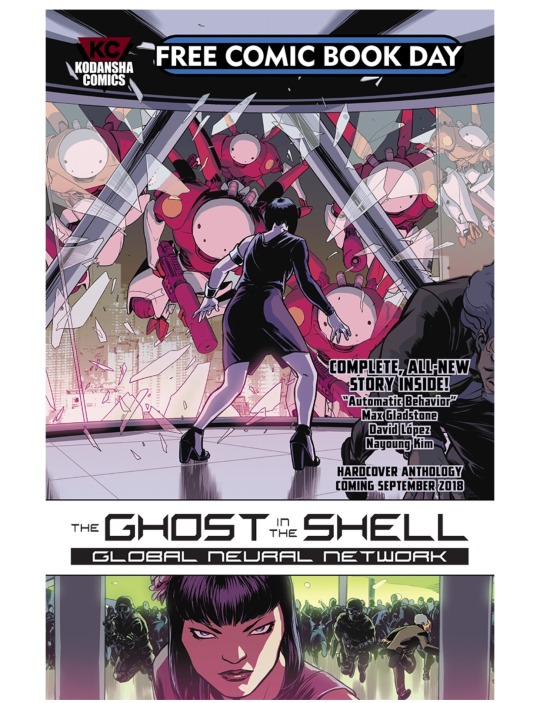
6. THE GHOST IN THE SHELL by Max Gladstone (w), David Lopez (a), Nayoung Kim (color), Jodi Wynne (l), Alejandro Arbona (e), Ben Applegate (e). (Kodansha).
Major Kusanagi (aka Motoko) and Aramaki are intercepted by an American Ghost Force Squad while on a business trip to Shangai. After her arrest, Motoko dramatically escapes through the streets of Shangai and meets her old wartime enemy, Li; the pair must work together to save Aramaki and others. This issue, part of an upcoming anthology, is perhaps the most complete, cover-to-cover, issue released on FCBD. At a whopping forty-five pages, readers are treated to an entire story that is exceptional all on its own. This is a fabulous issue that will convert even the most stoic of non-believers into fans of this character and this series.

5. RELAY by Zac Thompson (w), Andy Clarke (a), Eric Bromberg (st), Donny Cates (st), Dan Brown (color), Charles Pritchett (l), Mike Marts (e). (Aftershock).
In this sci-fi story, a space traveler lands on a planet with an undeveloped population and offers them “the Relay,” a monolith that creates uniformity in technology and ideas. Is it intergalactic socialism, or will it be intergalactic fascism? The Relay seemingly destroys community identity and cultural heritage with a new sort of religion: ultimate fath in the monolith itself. This is an expertly paced and well-rendered metaphor that gives sci-fi fans something deeper to ponder.

4. MIGHTY MORPHIN POWER RANGERS by Kyle Higgins (w), Ryan Parrott (w), Digo Galindo (a), Marcelo Costa (color), Ed Dukeshire (l), Dafna Pleban (e). (Boom!).
This one takes me back! Chosing to advertise its best-selling series, Boom! strategically used its FCBD option to bridge the gap between fans of the old TV show(s) and the current comics mythology, hoping to draw in readers who may have been overwhelmed by the thousands of different Power Ranger characters and their convoluted origin stories and missions. This issue is a straight-forward explanation of how the first episode of the original TV series connects to the comic storyline today, with some surprisingly awesome artwork and a shockingly murderous ending. The issue concedes its childish origins, but by the end, these aren’t your kids’ Power Rangers anymore!

3. AVENGERS by Jason Aaron (w), Sarah Pichelli (p, i), Elisabetta D’Amico (i), Justin Ponsor (color), Cory Petit (l), Tom Brevoort (e). (Marvel).
This issue, frankly, defied my expectations. As the official free preview to Marvel’s “Fresh Start,” there was a lot riding on this issue, the release of which coinciding with yet another reboot of the Avengers in the same week and a blockbuster weekend for the House of Ideas at the cinema a week prior. And it did not disappoint. In a direct follow-up to last year’s Marvel Legacy #1, Odin meets with Black Panther in the ruins of Asgard. Odin explains that he has fallen to Loki and his manipulation of a Celestial and requests that T’Challa kill Loki; he agrees. The story ends in another scene with Captain America and Thor reaching out to Tony Stark for a meeting between the three of them as a new Avengers era begins. Rather than using its FCBD offering to pump in half-assed action, Aaron instead tries to win new readers over with a well-told and interesting story setup. It is refreshing to see Marvel return to storytelling in its flagship series rather than resort to the redundant tropes of its recent past. Very well done.
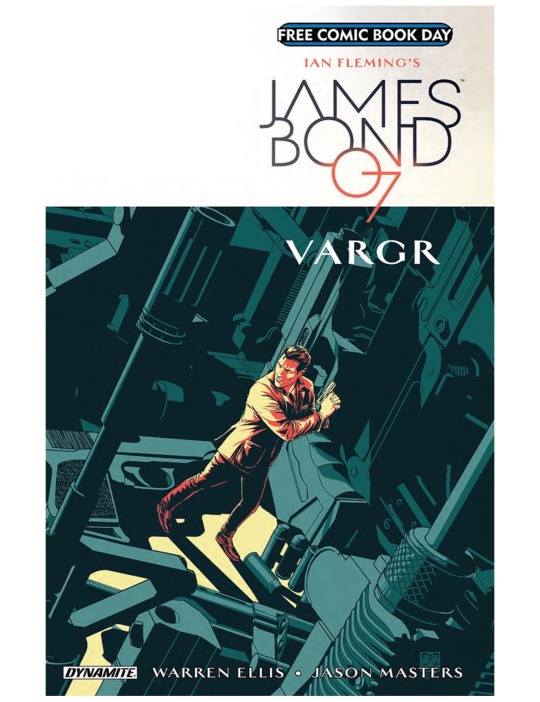
2. JAMES BOND 007: VARGR by Warren Ellis (w), Jason Masters (a), Guy Major (color), Simon Bowland (l), Joseph Rybant (e). (Dynamite).
On a mission in Finland, 007 hunts down 008’s killer and exacts gruesome revenge. Later at MI6 Headquarters, M is assigned to take over 008’s case load, setting up a story that is simultaneously exhilirating for new readers and faithful in spirit to fans of the classic Bond. With darkly exquisite artwork throughout (particularly the Helsinki scene) and a character whose charm radiates off the page, it’s hard to imagine any comic fan not falling madly in love with this series. Originally published in 2016, this issue and the rest of the story is already available in trade.

1.BARRIER by Brian K. Vaughn (w), Marcos Martin (a, c), Muntsa Vincente. (Image).
No comic in this bunch left my jaw on the floor and mouth agape quite like this one. In this exquisite story, Liddy discovers signs of a Mexican cartel using her land, which happens to be on the Texas-Mexican border, as a throughway for drug trades and illegal immigration. In a parallel story, Oscar migrates from his home in Honduras to reach the U.S., crossing onto Liddy’s land in the middle of the night. She finds him and holds him at gunpoint suddenly the pair are interrupted. It’s a contemporary story involving gruesome violence, cartels, guns, and sci-fi. Half the issue is in Spanish (a language deficit won’t detract from your enjoyment of the issue), and the entire book – at an impressive fifty-three pages – is elegantly printed in landscape format. The artwork is phenomenal. The writing is incomparable. This is simply a perfect comic book from cover to cover. Frankly, I’m shocked it was available for FCBD as it’s well-worth a cover price. I recommend this enthusiastically, and I can’t wait to pick up the whole series this month. An exceptional beauty of a comic.
THE WORST

3. SHADOW ROADS by Cullen Bunn (w), Brian Hurtt (w), A.C. Zamudio (a), Carlos Zamudio (color), Crank! (l), Charlie Chu (e). (Oni Press).
In this deeply convoluted introduction presumptively set in the late nineteenth century, we meet Henry Grey, a Native American and a Cambridge man who visits the British Museum of Natural History’s new Native American exhibit with remorse and perhaps disgust. He meets an elder at the Museum who gives him a magical ceremonial dagger carved from bone that ultimately lights up. En route home, his train passes through a Crossroads where Abigail Redmayne and Kalfu intercept him and bring him to the New Mexico Territory. What causes this issue to fail – aside from the onslaught of new characters to learn and an unexplained mythology to understand – is that by the issue’s end, we are no closer to knowing why any of these events occur. Why does Abigail bring Henry to New Mexico? What is so special about Henry? What’s the point of the glowing dagger? While a free comic book should purposefully leave questions unresolved to entice readers to find their answers in subsequent issues, this romp is sadly too obscure and complicated to elicit any interest.
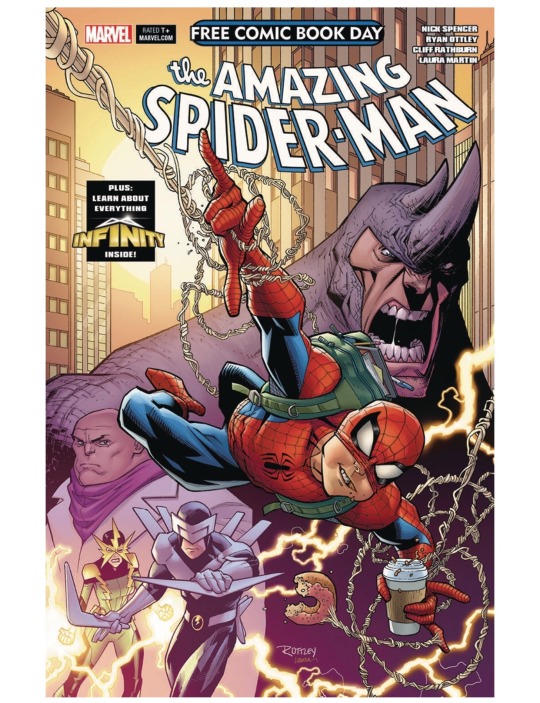
2. AMAZING SPIDER-MAN by Nick Spencer (w), Ryan Ottley (o), Cliff Rathburn (i), Laura Martin (color), VC’s Joe Caramagna (l), Nick Lowe (e). (Marvel).
Facing off against America’s greatest threat – the Manhattan real estate market – Peter Parker and his buddy Randy look for an apartment when they are interrupted by a fight with Boomerang, Electro, Rhino, and Big Wheel. After a quick costume change, Spider-Man battles them all until Kingpin intervenes. Despite the Mayor’s apparent gratitude for Spider-Man, Peter drops his professionalism instantly and leaves the scene. Later, Randy and Peter settle on a new three-bedroom apartment with a third roommate: Boomerang himself. From the ludicrous dialogue, the boring trope-laden plot, the cartoonish graphic design, and the overall neutering of Peter Parker’s character, this was a deep, deep disappointment for me that goes beyond this single issue; if this was meant to be an advertisement for the new Amazing Spider-Man series, I’m afraid it did more to turn me off than on. In addition, despite picking up all fifty-two free comics on FCBD, this issue is the only one with running ink and cheap printing errors. Oh, Marvel. Why do you do this to me?

1. TANK GIRL by Alan Martin (w), Brett Parson (a), Warwick Johnson-Cadwell (a), Jonathan Edwards (a), Brett Parson (l), Martin Eden (e). (Titan).
This was perhaps my fault for setting my expectations too high. Having never read a Tank Girl comic and only vaguely understanding her origins from nineties samples and the Lori Petty film, I was expecting a post-apocalyptic badass who breaks the fourth-wall and uses ingenuity, humor, grit, and charm to fight the Man. Instead, I got an insufferable cutsey-wootsey romp about a woman face-punching an adult man after he ruined her birthday big wheel when they were children. In between this awful plot’s progression, vignettes either drawn by a child or rendered to look like it had been drawn by child are too annoying to attempt to read. The only enjoyable bit of this comic was the cover by Jamie Hewlett, who should have done the interiors as well.
1 note
·
View note
Text
The Ten Best Films of 1967
Bosley Crowther, The New York Times, 24 December 1967
THIS was the year in which Hollywood—or the home-grown film, if you please—made a remarkable emergence from the shadow of eclipse into which it had been cast by foreign imports and the weakness of its own energies in the past several years. Suddenly, against a record that showed a consistent decline in numerical representation since 1961, the Hollywood moviemakers have landed on my “10 best" list this year with no less than four solid entries, and with a respectable sprinkling on the honorable mention list.
Unstinting credit for this rebound to critical respectability must be given to those producers and directors who have finally responded to the cry for pregnant themes in the contemporary span of social tensions, rather than drift with a flat escapist tide. But it must also be acknowledged that a certain lessening was evident this year in the quality of foreign-language pictures, punctuated only by the emergence of individual, isolated surprises from young directors scattered from Sweden to Spain.
This was a year marked by ugly explosions of violence and sadism in many films, much of it meritricious and generated merely to shock. There are some elements of violence in films on the forthcoming list. But they are artfully restrained and developed to make valid and socially meaningful points. I am happy to conclude that the entries on this last year-end balance that I’ll draw up are as brilliant in their way and as impressive as those on the first I ever did.
So here they are, put down in the order in which they opened in New York:
La Guerre Est Finie (The War Is Over), screenplay by Jorge Semprun; directed by Alain Resnais; produced by Sofracime of Paris and Eu-ropa-Film of Stockholm; released by Brandon Films. This reflection of two days in the life of an aging Spanish left-wing agitator on a secret trip to Paris to visit his mistress and make contact with the Communist leaders there embraces a complex of emotions, memories, loyalties, and is ono of the finest comprehensions of growing old in today’s world yet filmed. Yves Montand, Ingrid Thulin and Genevieve Bujold play it beautifully.
Ulysses, screenplay by Joseph Strick and Fred Haines, based on the novel by James Joyce; directed by Mr. Strick; a Walter Reade, Jr.-Joseph Strick Production, released by Continental. A faithful and brilliant screen translation of Joyce’s classic novel, done with taste, imagination and cinema artistry. Most notable and commendable are the candor and clarity with which Joyce’s ribald language and erotic images are presented to achieve understanding and the rhythm and ring of poetry. Maurice Roeves as Stephen Dedalus, Milo O’Shea as Leopold Bloom and Barbara Jefford as his wife, Molly, are superior in an excellent cast.
The Hunt, screenplay by Angelino Fons and Carlos Saura; directed by Mr. Saura; an Elias Querejeta Production, released by Trans-Lux. In this brilliantly expanding drama of four men on a seemingly innocent rabbit-hunting trip in a barren area fought over in the Spanish Civil War, Mr. Saura vividly presents us with a bitter and horrifying expose of the spiritual poverty and frustration of middle-aged men who were involved in that war—on the side of the Falangists. One of the rare Spanish films released here, it acquaints us with a strong young directorial talent and new, bold spirit in Spain.
In the Heat of the Night, screenplay by Stirling Silli-phant, based on the novel by John Ball; directed by Norman Jewison; produced by Waller Mirisch of the Mirisch Company for United Artists. The hot surge of racial hate and tension as it has been displayed in many communities this year is fictionally isolated and put forth with realism and point in this strong drama of a Northern Negro detective up against a mystifying murder and an antagonistic white sheriff in the South. Sidney Poitier and Rod Steiger give Oscar-worthy performances.
Father, screenplay by Istvan Szabo; directed by Mr. Szabo and produced by Ma-film Studio III of Budapest, Hungary; released by Continental. Again, an exciting creation from a fresh talent on the European scene is manifest in this study of a young Hungarian's heroic fantasies of his dead father, wherein are reflected his emotional insecurity and his need for a sense of heritage in a changing world. Fine performances by several young people and a fluid, forceful cinematic style distinguish what might be considered a significant achievement of a Hungarian “new wave.”
Elvira Madigan, screenplay by Bo Widerberg; directed by Mr. Widerberg, and produced by Janco/Europa Film; released by Cinema V. A new, young Swedish director swims impressively into our ken with this pictorially exquisite and dramatically absorbing story of a pathetically doomed love affair between a young married Swedish cavalry officer and a beautiful circus girl, all in the serene long ago. Thommy Berggren and Pia Degermark fairly break one’s heart in the principal roles. The creative use of color and of Mozart’s music is memorable.
Closely Watched Trains, screenplay by Bohumil Hrabal and Jiri Menzel, based on a story by Mr. Hrabal; directed by'Mr. Menzel, and produced by Film Studio Bar-randov of Prague, Czechoslovakia; a Sigma III release. In the naturalistic tradition of several recent fine Czechoslovak films, this humorous, revealing and poignant drama of a hopeful, immature young railway-station attendant at a country station in World War II is richly cinematic and full of humanity and tenderness. Vaclav Neckar as the young hero and Jitka Bendova as an older attendant are delightful in a fine cast.
Cool Hand Luke, screenplay by Donn Pearce and Frank R. Pierson, based on a novel by Mr. Pearce; directed by Stuart Rosenberg, and produced by Gordon Carroll for Warner Brothers-Seven Arts. This tough convict-camp melodrama about a cryptic, alienated young chap, caught between the heroization of his fellow prisoners and the ruthless deflating of the guards, is a good, solid chunk of raw meat, cinematically and otherwise, in a year in which films of brutality and violence have too often been overdone. Paul Newman as the hero, George Kennedy as a fellow con and Jo Van Fleet in a small role do especially well.
In Cold Blood, screenplay by Richard Brooks, based on the novel by Truman Capote; directed and produced by Mr. Brooks for Columbia. Here, in this starkly realistic and electrifyingly illuminating film, based on the classic in-depth study of an actual Kansas quadruple murder case, Mr. Brooks brilliantly provides us with a comprehension beyond the scope of this one case of the harrowing hazard of random crime and senseless violence in our communities. Excellent performances by two comparative newcomers, Scott Wilson and Robert Blake, in the roles of the neurotic killers, and a strong, expressive musical-sound score by Quincy Jones are among the several Oscar-worthy efforts in this film.
The Graduate, screenplay by Calder Willingham and Buck Henry, based on a novel by Charles Webb; directed by Mike Nichols, and produced by Lawrence Turman for Embassy Pictures. This sharply incisive and funny picture about the social and amorous problems of a young man fresh out of college is thematically and cinematically one of the best American social satires that has come along in years, and it offers in the title role a new young actor, Dustin Hoffman, who is nothing short of superb. Anne Bancroft as a restless older woman and Katharine Ross as her daughter also shine.
There are my ”10 best” selections. But I would like, as I did last year, to note several films that were contenders for places on this list. They may be classed as Honorable Mentions, with no gradation among them—and here they are:
Persona — Ingmar Bergman’s superb, disturbing study of a clashing dual personality, beautifully played by Bibi Andersson and Liv Uilmann.
Marat/Sade — A brilliant cinematic enactment of the powerful Peter Weiss stage play about insanity and revolution, directed by Peter Brook.
The War Game — A hypothetical study, done in tele-vision-documentary style, of a nuclear bombing of Britain, directed by Peter Watkins.
Up the Down Staircase — The “blackboard jungle” broadened, with particular emphasis upon the devotion of a new high school teacher, played exceedingly well by Sandy Dennis.
Guess Who’s Coming to Dinner — A delightful, icebreaking drawing-room comedy about mixed marriage, charmingly played—and talked—by Spencer Tracy, Katharine Hepburn and Sidney Poitier.
The Battle of Algiers — Here is a scorching example of the old reenacted documentary-type film, directed with new vitality by Gillo Pontecorvo and played by a first-rate cast.
Privilege — What happens when a British “pop” singer is exploited for the benefit of The Establishment; highly suppositional but strong, also by Peter Watkins.
The Jokers — New British director Michael Winner satirizes the impatience and recklessness of younger members of the upper class.
The Tiger Makes Out — Murray Schisgal’s comedy-satire on New York loners, played delightfully by Eli Wallach and Arne Jackson.
There, that’s enough.
Here’s hoping for even better in 1968!
13 notes
·
View notes
Text
50 Years After 1968, Can the Young Change Politics? A Striking New Poll Says Yes by Richard Eskow
Fifty years ago, in the dust and fire of the global youth activism of 1968, everything seemed possible. The political world was a cloud filled with chaos and opportunity, pain and promise. The young were a powerful force, even a world-changing one.
Could they become that force again?
As many Millennials vote for the first time today in state primaries from New Jersey to Iowa and California, a new poll of their views offers some intriguing glimpses into the future.
The survey finds that most Millennials want “a strong government” to manage the economy, and that most millennial Democrats have a favorable view of socialism.
What do this poll, and the past, say about our political future?
The Young Left
It’s more than a truism to say Millennials are this country’s political future. As Pew’s Richard Fry has noted, “Baby Boomers and other older Americans are no longer the majority of voters in U.S. presidential elections.” Fry thinks millennial votes could well surpass those of Generation X in 2020. He adds: “Millennials are likely to be the only adult generation whose number of eligible voters will appreciably increase in the coming years.”
A new survey from the University of Chicago’s GenForward project suggests that these voters could pull the Democratic Party, and American politics, sharply to the left. The survey of 1,750 respondents found that “Majorities of Millennials across race and ethnicity believe a strong government rather than a free market approach is needed to address today’s complex economic problems.”
What is this growing group of voters likely to make of Democrats like the three senators – Heitkamp, Tester, and Donnelly – who recently cosponsored a bill to loosen the Volcker Rule’s safeguard provisions on almost all of America’s banks?
In the survey’s most striking finding, 61 percent of Millennial Democrats polled – nearly two-thirds – expressed favorable views of socialism. The report notes that 32 percent of independents and “only” 25 percent of Republicans say they are favorable toward socialism.
“Only?” t’s fascinating to ponder the prospect of a Republican Party that’s one-quarter socialist.
The study also shows that the “rising Democratic majority” of black and brown voters isn’t very fond of capitalism, for understandable reasons. Only 45 percent of Latinxs and 34 percent of African-Americans hold favorable views of capitalism.
These results suggest that Democratic leaders are ill-advised to insist, as Nancy Pelosi and Hillary Clinton both did recently, that theirs is a strictly capitalistic party. Clinton’s dismissive tone toward socialist-leaning Democrats seemed especially counterproductive.
This young, black, and brown rejection of capitalism is consistent with a recent Harvard-Harris poll, which found that a majority of Democrats (again, of all ages) “support… movements within the Democratic Party to take it even further to the left and oppose the current Democratic leaders.”
Support for the left was greatest among female voters (55 percent), Hispanic voters (65 percent), and African-American voters (55 percent). The Harvard-Harris poll also found that 69 percent of young voters supported these left movements. How do these findings about today’s Young Left square with the experience of 1968?
It Was Fifty Years Ago Today
Polling data from 1968 on the young is hard to come by. But youth activists – roughly defined as those aged 30 or under – had an enormous global impact that year. In the United States and Europe, an ongoing wave of antiwar protests started in 1967 and carried over into the New Year.
In January of 1968, the election of reformer Alexander Dubcek to head the Communist Party of Czechoslovakia prompted hopes for peaceful decentralization and democratization in the Eastern Bloc, and the youth protests of the Prague Spring.
In March of 1968, antiwar presidential candidate Eugene McCarthy stunned the political world with his near-defeat of President Lyndon Johnson in the New Hampshire primary. Youth volunteers, many of them veterans of the peace movement, received much of the credit for McCarthy’s results.
Robert F. Kennedy launched his campaign the following week. His move split the student left. Some saw Kennedy as a carpetbagger. Others were drawn to his anti-poverty and civil rights stands, which seemed to be backed by greater passion than McCarthy’s.
RFK’s charisma, and his long hair, didn’t hurt. “Get a haircut,” a rally goer shouted. “You sound like my mother,” Kennedy jokingly responded.
Other young people rejected the prevailing set of electoral choices altogether, pushing for more radical change through third parties or movement organizing. Protests at Columbia University began in early April and quickly became an occupation.
Martin Luther King, Jr., who had been preparing a multiracial and multi-cultural Poor People’s Campaign in Washington D.C., was gunned down on April 4. Riots quickly broke out in ghettoes across the country, as the pressurized forces of poverty, racism, and hopelessness were ignited by the murder of a black man who represented the finest in the human spirit.
Kennedy announced King’s death to a crowd in Indianapolis, saying, “Martin Luther King dedicated his life to love and to justice between fellow human beings. He died in the cause of that effort.”
“In this difficult day, in this difficult time for the United States,” Kennedy said, “it’s perhaps well to ask what kind of a nation we are and what direction we want to move in.” Kennedy called on his audience to “dedicate ourselves to what the Greeks wrote so many years ago: to tame the savageness of man and make gentle the life of this world.”
On May 4, members of the Ohio National Guard gunned down unarmed and peaceful student demonstrators, killing four and wounding nine. On April 11, German student leader Rudi Dutschke was shot by a right-wing gunman after a concerted media campaign from the right-wing Axel Springer group. One headline in the Springer-owned Bild newspaper read, “Stop Dutschke now!”
In May, an anti-capitalist and anti-imperialist student uprising in France began with the occupation of university buildings. It quickly spread to other corners of society, as massive street demonstrations led to the occupation of factories and nationwide strikes. Between 10 and 11 million French workers – more than 20 percent of the population – went on strike. Many people believed the government of Charles de Gaulle might all.
On June 5, 1968, Robert F. Kennedy was assassinated in Los Angeles on the night of the California primary. On August 20, Soviet tanks rolled into Czechoslovakia, crushing the Prague Spring, and one week later, Chicago police viciously attacked antiwar protestors outside the Democratic National Convention.
To many people, it began to feel like the surging wave of violence would never end.
Protests to Polling Booths
There are those who say that the promises of spring died quickly in 1968, and that the youth movement’s hope for change in that year was an illusion.
It certainly didn’t lead to electoral victories. After fleeing France in apparent confusion and fear, De Gaulle returned and won an overwhelming electoral victory. In the United States, the chaotic Democratic convention showcased the worst of the party’s internal corruption.
Chicago Mayor Richard J. Daley oversaw the violent police attacks on demonstrators, which a commission later deemed a “police riot,” and Vice President Hubert Humphrey won the party’s nomination under a cloud of bitterness and recrimination.
Richard Nixon eked out a narrow victory over Humphrey that year, after claiming to speak for a “Silent Majority” of non-demonstrating Americans. Nixon won 43.42 percent of the vote, Humphrey won 42.42 percent, and the racist George Wallace won 13.53 percent as a third-party candidate.
The Outcomes Of 1968
These results have been used to argue that the protests of 1968 were a political failure. In one sense, that’s clearly true. Hamstrung by media coverage, the two-party system, internal conflict, and the transformative nature of its agenda, the left failed to build an electoral majority in 1968.
Its social and cultural impact was undeniable, however. The youth movement changed music, language, style, and the arts. Its embrace of what was then called “women’s liberation” helped give rise to feminism, one of the most transformative political and social movements of modern times. Its multiracial and multicultural orientation reinforced black and brown alliances with the economic left.
In April, a higher court upheld Muhammad Ali’s conviction for refusing induction into the military over the war in Vietnam. Controversial and banned from fighting, Ali traveled the country, developing what would become a long, ground-breaking, and distinguished career as an activist and advocate for social justice.
At the Summer Olympics in October 1968, winning athletes John Carlos and Tommy Smith gave the black power salute from the podium. As Carlos later explained, he had unzipped his Olympic jacket as a show of solidarity with “all the working-class people — black and white — in Harlem who had to struggle and work with their hands all day.” Carlos and Smith had one pair of black gloves between them, so Carlos raised his left fist and Smith raised his right.
These struggles live on today – in Black Lives Matter, in the NFL protests, and in the intersectional fight for class justice. But can left-leaning gestures and movements ever turn into an electoral force in this country, as they once promised to become?
The Future Primary
The political challenge is clear. More than one poll has affirmed that our country’s rising political demographic group wants to see more government intervention in the economy. Young Democrats lean socialist, and people of color are disillusioned with the capitalist system.
That doesn’t necessarily mean they will become activists. They may simply become alienated from the political process. In fact, it’s already happening. “(L)ess than 26% of Millennials of any racial or ethnic background,” the study says, “have favorable views of the political parties or Congress.”’ Democrats are in danger of losing their core voters.
Still, there are hopeful signs. There is a rising wave of activism among Millennials. They are running for office, organizing political actions, and taking other steps to become involved in the political process. Members of the generation that follows them have organized against school shootings, and have done so in an intersectional way.
Activism, whatever its form, is a precursor to change. According to these polls, the “leftism” of today is poised to become the political center of tomorrow. And a new generation may be prepared to rediscover the words of Dr. Martin Luther King, Jr.: “When people get caught up with that which is right and they are willing to sacrifice for it, there is no stopping point short of victory.”
\
0 notes
Text
William Kerns’ Movie Marquee — 5 films open in Lubbock movie theaters
MOVIES OPENING FRIDAY
7 Days In Entebbe
Israeli soldiers embark on a mission to rescue more than 240 hostages from an airport in Entebbe, Uganda, in the summer of 1976.
PG-13: Violence, thematic material, drug use, smoking and language — Premiere Cinemas.
^
A Fantastic Woman
Sebastian Lelio’s “A Fantastic Woman” made history twice when it won the Academy Award on March 4 for Best Foreign Language Film. It was the first Oscar win for a film from Chile, and the first Oscar win for a movie with a transgender character in the leadThe movie focuses on waitress and singer Marina, portrayed by transgender actress Daniela Vega, fighting for her dignity while grieving after her boyfriend Orlando (Francisco Reyes) dies, apparently from a brain aneurysm. Marina is viewed with suspicion by a detective, doctors and even Orlando’s family, the latter forbidding her from attending the wake or funeral.
R: Language, sexual content, nudity and disturbing assault — Alamo Drafthouse.
^
I Can Only Imagine
Based on the incredible true-life story that inspired the beloved, chart-topping song, “I Can Only Imagine” is a song that brings ultimate hope to so many. Amazingly, the song was written in mere minutes by MercyMe lead singer Bart Millard. In reality, those lyrics took a lifetime to craft.
PG: Thematic elements including violence — Tinseltown 17, Movies 16 and Stars & Stripes Drive-In.
^
Love, Simon
Everyone deserves a great love story, but for 17-year-old Simon Spier, it’s a little more complicated. He hasn’t told his family or friends that he’s gay, and he doesn’t know the identity of the anonymous classmate that he’s fallen for online. Resolving both issues proves hilarious, terrifying and life-changing.
PG-13: Thematic elements, sexual references, language and teen partying — Premiere Cinemas, Alamo Drafthouse, Tinseltown 17 and Movies 16.
^
Tomb Raider (3-D/2-D)
Still based on the 2013 video game of the same name. Alicia Vikander now stars as Lara Croft, the fiercely independent daughter of an eccentric adventurer who vanished years earlier. Hoping to solve the mystery of her father’s disappearance, Croft embarks on a perilous journey to his last-known destination: a fabled tomb on a mythical island off the coast of Japan. The stakes couldn’t be higher as Lara must rely on her sharp mind, blind faith and stubborn spirit to venture into the unknown.
PG-13: Thematic elements and violent images — Premiere Cinemas (includes IMAX), Alamo Drafthouse, Tinseltown 17 (includes XD) and Stars & Stripes Drive-In.
^
MOVIES CONTINUING
12 Strong
Kerns rating: Three and one-half stars
Danish director Nicolai Guglsig’s movie is an entertaining tale about little-known horse soldiers, the first American military allowed to take the fight to the Taliban and al-Qaida allies in Afghanistan weeks after the 9/11/2001 attack. The story captures Americans’ reaction. Based on declassified accounts and Doug Stanton’s 2009 book “The Horse Soldiers,” the film focuses on the Fifth Special Forces Group and Captain Nelson (Chris Hemsworth) who, though inexperienced in war, pledged to bring everyone home alive. Guglsig focuses on Hemsworth, his initial lack of “killer eyes” and uneasy relationship with the Northern Alliance general (Abdul Rashid Dostum) whom he must befriend. Matters are helped by Nelson having been raised on a ranch and thus comfortable on horseback — because many battles must be waged while riding into battle, automatic weapons blazing.
R: War violence and language — Movies 16.
^
Annihilation
Kerns rating: Four stars
Alex Garland’s sci-fi drama “Annihilation” — admittedly not for everyone, and inspired by Jeff VanderMeer’s “Southern Reach Trilogy” — is helped mightily by an eerie original score and wildly innovative visual effects. Phrased in nostalgic terms, this film will blow a lot of minds. Audiences learn the military tried repeatedly to cross a colorful barrier within the United States, aptly called the Shimmer, in an attempt to discover how Area X beyond has been affected. Only one soldier, Kane, returned alive, if not mentally whole, from a possible environmental disaster zone. The military has five female scientists try next. Biologist and former soldier Lena, (Natalie Portman) wisely tells no one that Kane is her husband. Joining her: an anthropologist, psychologist, surveyor and linguist (Jennifer Jason Leigh, Tessa Thompson, Gina Rodriguez and Tuva Novotny). Not all will return. What they discover defies laws of nature. Don’t give too much away, although the film at times seems like one big spoiler. Can there be an alien, not necessarily extraterrestrial, wielding molecular change — and intruders possibly internally consumed? Time is an unspoken factor; the Shimmer is approaching cities as Area X expands daily. Good luck grasping it all. Garland’s “Ex Machina” may be the better film, but I can’t wait to see what he does next.
R: Violence, bloody images, language and sexuality — Premiere Cinemas and Tinseltown 17.
^
Black Panther (3-D/2-D)
Kerns rating: Four and one-half stars
The intelligent script conjures thought and questions. Directing only his third film, Ryan Coogler makes stunning decisions. Viewers will be awed when introduced to the apparent Third World African country of Wakanda, which resisted being colonized by all who might discover its source of Vibranium, which has been used used to secretly transform Wakanda into the world’s most advanced culture and civilization. Art direction, costumes and music are perfectly realized, as is the manner in which the nation’s women play vital roles. As Chadwick Boseman returns home for his own inauguration, he reunites with Lupita Nyong’o, one of Wakanda’s many spies, and soon is advised by Danai Gurira, who leads the country’s security forces. Stealing scenes is charismatic and funny newcomer Letitia Wright as T’Challa’s half sister. She also is Wakanda’s James Bond-ish Q,CQ a courageous technical genius providing equal numbers of gadgets and one-liners.
PG-13: Action violence, and rude gesture — Premiere Cinemas, Alamo Drafthouse, Tinseltown 17 and the Stars & Stripes Drive-In.
^
Death Wish
Kerns rating: Two stars
The first “Death Wish” iturned around Charles Bronson’s career, to the point that he was still making “Death Wish” sequels in his 70s. There was no call for a remake, even with a better performance from Bruce Willis as pacifist turned modern day vigilante Paul Kersey. His wife and college-age daughter (Camila Morrone) are attacked in their home in a robbery gone bad. His wife is killed; his daughter survives, and Kersey happens upon an unregistered gun and walks the streets, looking for hoodlums to shoot.
R: Vloody violence, and language — Premiere Cinemas, Alamo Drafthouse, Tinseltown 17 and Movies 16.
^
Every Day
Angourie Rice stars as a shy, 16-year-old girl named Rhiannon, who falls in love with a traveling soul named “A,” who wakes up every morning in a different body, living a different life each day.
PG-13: Thematic content, language, teem drinking and suggestive material — Premiere Cinemas.
^
Ferdinand (3-D/2-D)
Kerns rating: Three stars
Hardly Pixar-level storytelling. Director Carlos Saldanha could not resist placing a bull in a china shop, with predictable results. Yet it remains an amusing tale, a loyal adaptation of 1936 children’s book “The Story of Ferdinand,” written by Munro Leaf and illustrated by Robert Lawson, a story not seen on screen since the Disney cartoon in 1938. Ferdinand — ironically voiced by wrestler-turned-actor John Cena — is bullied as a youngster for preferring to smell flowers. He finds true happiness when he escapes and is rescued by the owner of a flower plantation and his daughter. Naturally, Ferdinand grows (and grows) and is mistaken for a prime opponent by an undefeated matador.
PG: Rude humor, action and thematic elements — Tinseltown 17.
^
Fifty Shades Freed
The final installment of a film trilogy adapted from novels by British author E.L. James. Billionaire entrepreneur Christian Grey (Jamie Dornan) and Anastasia Steele (Dakota Johnson) are a couple finding happiness with a BDSM sexual relationship.
R: Erotic sexual content, graphic nudity and language — Premiere Cinemas.
^
Forever My Girl
Liam Page (played by Alex Roe) left sweetheart Josie Preston (Jessica Rothe) at the altar. He ran away for a shot at fame. Josie tries her best to keep Liam at a distance, but life has one more surprise awaiting him.
PG: Thematic elements including drinking, and language — Tinseltown 17.
^
Game Night
Kerns rating: Two and one-half stars
Comedy is still, as they say, hard. Happily, co-stars Rachel McAdams and Jason Bateman shine as married and mutually competitive game nerds who share legitimate charisma and inspire smiles. They play Annie and Max, whose couples game night is one-upped when Max’s richer, more popular brother Brooks (Kyle Chandler) calls on a local company called Murder We Wrote to host a party in which guests try to win by solving a realistic murder mystery. Naturally, for the few who missed the trailer, fake thugs and federal agents are replaced by dangerously real crooks.
R: Language, sexual references and violence — Alamo Drafthouse, Tinseltown 17 and Movies 16.
^
The Greatest Showman
Kerns rating: Three stars
Hugh Jackman impresses in his dream role of P.T. Barnum, but the storytelling is shallow. A few songs are memorable (such as “This Is Me”), yet there is precious little story exposition between them. Deserving applause is choreography by Ashley Wallen, revealing fantastic rapport with director Michael Gracey. Jackman and Efron are musical veterans, and it shows. Michelle Williams is tragically underused as Charity Barnum, who is aware when her husband is captivated by Swedish performer Jenny Lind. Social statements blend into entertainment and, by the end, good gosh, even elephants seem to appear out of nowhere.
PG: Thematic elements, including brawl — Premiere Cinemas and Movies 16.
^
Gringo
Harold Soyinka (David Oyelowo) is an average businessman who works for a company that has developed a “Weed Pill,” medical marijuana that has been simplified to pill form. His bosses, Elaine (Charlize Theron) and Richard (Joel Edgerton), send him to Mexico to handle the marketing of the product. However, while out partying, he is kidnapped by a cartel — specifically one that holds a grudge against Harold’s bosses and their company. Richard hires a professional named Mitch (Sharlto Copley) to safely remove Harold from harm’s way, but Mitch and Harold end up having to survive one outrageous situation after another.
R: Language, violence and sexual content — Premiere Cinemas and Tinseltown 17.
^
Hostiles
Kerns rating: Five stars
This 2017 drama from writer-director Scott Cooper, like Clint Eastwood’s “Unforgiven” in 1990, proves the western is not dead — while taking a darker approach examining characters on the edge, affected by lives of brutal violence. The main characters, U.S. Cavalry Capt. Joseph Blocker (Christian Bale) and Northern Cheyenne war chief Yellow Hawk (Wes Studi), developed bitter hatred for one another over years of bloody battles, until the latter was captured and incarcerated. The story opens in 1892. Blocker, nearing retirement, has finished a campaign against the Apache; yet Comanches continue to murder homesteaders for horses, recently a father and three children in merciless fashion. The mother (Rosamund Pike) survived by hiding, and emerges emotionally broken. Blocker is ordered to escort Yellow Hawk, who contracted cancer during seven years of confinement, and his family from a New Mexico fort to ancestral grasslands in Montana, by order of President Benjamin Harrison. Crossing paths with marauding Comanche, dangerous fur trappers and racist whites, their survival odds are slim. “Hostiles” is special, however, because of character arc and change; this western also deals openly with post traumatic stress. Bale is incredible as he questions his own humanity; he is heartbreaking during his “I had a friend” monologue, and dodges a racist tag when he calls black Buffalo Soldier Henry the best soldier he’s ever known … and may also mean best friend. Bale learned to speak Northern Cheyenne, which grants enhanced authenticity to conversations with the brilliantly subtle Studi. Pike is outstanding, as is Jonathan Majors as Henry and so many others in a drama working on varied levels.
R: Violence and language — Movies 16.
^
The Hurricane Heist
A rural Alabama town faces two problems. There’s a hurricane bearing down on the Gulf coastline, and there’s a team of 30 well-armed mercenaries intent on looting the local treasury facility.
PG-13: Gun violence, action, destruction, language and suggestive material — Premiere Cinemas, Tinseltown 17, Movies 16 and Stars & Stripes Drive-In.
^
Jumanji: Welcome to the Jungle (3-D/2-D)
Kerns rating: Three and one-half stars
Kudos to the writing, casting and performances — even considering CGI improvements since Robin Williams introduced “Jumanji” in 1995. The story opens a la “The Breakfast Club,” with high school detention again populated by types: skinny nerd Spencer (Alex Wolf); football jock Fridge (Ser’Darius Blain), pretty-turned-vain selfie-taker Bethany (Madison Iseman), and shy bookworm Martha (Morgan Turner). They find a game console (Jumanji), and barely hear African drums before being sucked into the game and transformed into adult avatars. The nerd becomes a smoldering, muscular adventurer (Dwayne Johnson), the jock is now a small whiner (Kevin Hart), a shy bookworm gives way to a Lara Croft-type (Karen Gillan), and sexy Bethany trades her body for that of middle-aged cartographer Jack Black. Adult avatars, however, maintain teenage personalities and fears. Kudos to director Jake Kasdan, who introduces CGI hippos, snakes and jaguars, but also one message about overcoming insecurities and another involving the four opposites working together if they are to survive. The ensemble work shines, despite Black stealing several scenes as he channels his much-too-believable inner Bethany. Still, one wishes the game’s villains were something more African than greedy explorer Bobby Cannavale and dozens of goons on motorcycles. Motorcycles? In the jungle? Really?
PG-13: Adventure action, suggestive content and language — Tinseltown 17, Movies 16 (through Monday) and Stars & Stripes Drive-In.
^
Maze Runner: The Death Cure
The final chapter of a trilogy. In director Wes Ball’s finale, Thomas (played by Dylan O’Brien) again leads his group of escaped Gladers. To save their friends, they break into the last city, a WCKD-controlled labyrinth that may turn out to be the deadliest maze of all. They must makes it out alive to find answers to questions they have been asking since they first arrived in the maze.
PG-13: Sci-fi violence and action, language, and some thematic elements — Movies 16.
^
Peter Rabbit (3-D/2-D)
Peter Rabbit, the mischievous and adventurous hero who captivated generations of readers, now stars in his own irreverent film comedy with attitude. Peter’s feud with farmer Thomas McGregor (Domhnall Gleeson) escalates to greater heights as they rival for the affection of Bea (Rose Byrne), a sweet animal lover living next door. James Corden provides the voice of Peter. Margot Robbie, Elizabeth Debicki and Daisy Ridley provide the voices of Peter’s triplet sisters: Flopsy, Mopsy and Cottontail. Inspired by author Beatrix Potter’s stories about the same characters.
PG: Rude humor and action — Premiere Cinemas and Tinseltown 17.
^
Red Sparrow
Francis Lawrence, who directed the last three “Hunger Games” films, reunites with Jennifer Lawrence, introduced as Bolshoi prima ballerina Dominika Egorova, who faces a bleak future after suffering a career-ending injury. She has no choice but to become a Russian spy and train at Sparrow School, a secret intelligence service training candidates to use their minds and bodies as weapons. Egorova emerges a dangerous Sparrow after completing sadistic training. Matthew Schoenaerts portrays her uncle Ivan, who knows the former dancer will do anything to help her emotionally vital but infirm mother Nina (Joely Richardson). Charlotte Rampling is the icy headmistress running the training school, and Jeremy Irons is Russian General Vladimir Korchnoi, who knows just how far a Sparrow like Dominika can be trusted. It appears that Lawrence’s Sparrow is being convinced by CIA agent Nate Nash (Joel Edgerton) to become a double agent.
R: Violence, torture, sexual content, language, and graphic nudity — Premiere Cinemas, Alamo Drafthouse, Tinseltown 17 and Movies 16.
^
The Shape of Water
Kerns rating: Five stars
Academy Award winner: Best Picture. Sally Hawkins is incredible as mute, lonely Eliza Esposito, who forges a relationship with an amphibian male imprisoned in the government lab that she helps clean each night. Bookend narration by Giles, This fairy tale blooms into a tragic romance influenced by the director’s affection for 1954′s “Creature from the Black Lagoon.” A Cold War rages against the Russians, inspiring sadistic Col. Strickland (Michael Shannon) to drag the amphibian (Doug Jones) from a South American river. Upon attacking his captor, the amphibian is kept in chains and tortured. Yet this becomes a story about love and language, as Eliza secretly uses eggs, sign language and music to communicate. Del Toro reveals his affection for horror films, government conspiracies and, surprise, dreamy 1930s musicals — all within an original romance where everyone colors outside the lines. Cinematographer Dan Lausten creates amazing images in a flooded apartment, and composer Alexandre Desplat delivers a romantic score that also earned an Oscar. Wonderful support arrives from Jenkins; Octavia Spencer as Eliza’s friend and interpreter; and even Michael Stuhlbarg as a Russian spy.
R: Sexual content, graphic nudity, violence and language — Movies 16.
^
The Strangers, Prey at Night
Kerns rating: Two stars
In 2008, writer-director Bryan Bertino explored apathetic violence via “The Strangers.” A decade later, more near-mute, masked home invaders are in a sequel, this time written by Bertino and directed by Johannes Roberts. At times, the story is a super low budget salute to John Carpenter’s early work, at least “Halloween” and “Christine,” except now there are three Michael Myers pursuing a terrified family through a deserted trailer park. The other option is a bored generation for whom murder is just a Friday night option. Why kill? Why not? But moviegoers are too familiar with killers handling a knife, ice pick or axe. This time, three sociopaths — call them Dollface, Pin-Up and Man in a Mask — butcher two seniors and learn from an answering machine that relatives are on the way. Mom (Christina Hendricks) and Dad (Martin Henderson) arrive with son Luke (Lewis Pullman) while on their way to deliver troubled daughter Kinsey (Bailee Madison) to boarding school. Soon, all are separated, cell phones destroyed. Roberts juggles ’80s music and tense silence to enhance a few jump-scares. In an effort to avoid predictability, he ventures into silly boogie-man territory. Gore levels are inconsistent but, to the filmmaker’s credit, his stars at least seem to enjoy the chase as much as the kills.
R: Horror violence and terror , and language — Premiere Cinemas, Tinseltown 17 and Movies 16.
^
Thoroughbreds
Two upper-class teenage girls in suburban Connecticut rekindle an unlikely friendship after years of growing apart. Together, they hatch a plan to solve both of their problems by killing the stepfather of one.
R: Disturbing behavior, bloody images, language, sexual references, and some drug content — Alamo Drafthouse.
^
A Wrinkle in Time (3-D/2-D)
Kerns rating: Two stars
This is just a bump in director Ava DuVernay’s career. She already proved her chops. “Selma” was Oscar-nominated for Best Picture, and DuVernay’s amazing documentary “13th” (on Netflix) emerged educational, challenging and important. The next step for anyone in her place was to say yes when Disney came calling with a bucket of cash and a challenging story, dominated by a visual effects budget and bad dialogue. Major filmmakers had shied away from popular book “A Wrinkle in Time” since the 1960s. Now we know why. The script finds young girl Meg (Storm Reid) and little brother Charles Wallace (Deric McCabe) grieving for their dad (Chris Pine, scientist), who disappeared four years ago. The children are encouraged to save their dad and the world by Reese Witherspoon as Mrs. Whatsit, Mindy Kaling as Mrs. Who and Oprah Winfrey as Mrs. Which. Skipping ahead (spoilers), Meg finds self-confidence and we were bound to be reminded about the power of love. Special effects and pop songs both border on lame. Adventures never becomes fun. I look forward to DuVernay being given another great script, or maybe an opportunity to write one. I guarantee, she will survive this wrinkle.
PG: Thematic elements and peril — Alamo Drafthouse, Tinseltown 17, Movies 16 (includes XD) and Stars & Stripes Drive-In.
^
Ratings, from one to five stars, and reviews are by A-J Media film critic William Kerns.
Source Article
Learn More: http://www.sengokubusyou.com/william-kerns-movie-marquee-5-films-open-in-lubbock-movie-theaters/
1 note
·
View note